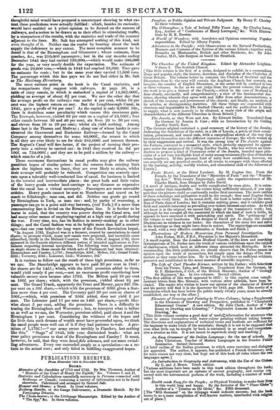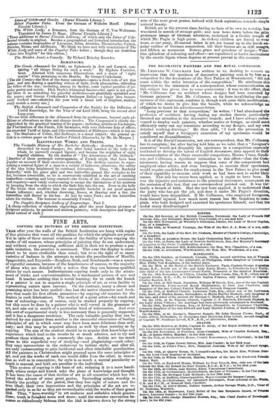PUBLICATIONS RECEIVED.
From November 14th So November 20th.
BOOKS.
Memoirs of the Jacobites of 1715 and 1745. By Mrs. Thomson, Author of "Memoirs of the Court of Henry the Eighth," &c. Volumes L and IL Statistics and Calculations essentsally necessary to Persons connected with Railways or Canals; containing a variety of information not to be found elsewhere. Calculated and arranged by Samuel Salt. Honour and Shame; a NoveL In three volumes.
Railway Results, or the Gauge Deliverance; a Dramatic Sketch. By Sir Fortunatus Dwarris.
71.3 Chain-Soarer; or the Littlepage Manuscripts. Edited by the Anther of "The Spy," &e. In three volumes. Pomfret; or Public Opinion and Private Judgment. By Henry F. Chorley In three volumes.
The O'Donoghue; a Tale of Ireland Fifty Years Aga By Charles Lever, Esq., Author of " Confessions of Harry Lorrequer," &c. With Illustra- tions by H. K. Browne.
A World of Wonders; with Anecdotes and Opinions concerning Poptdar superstitions. Edited by Albany Poyntz.
Adventures in the Pacific ; with Observations on the Natural Productions, Manners and Customs of the Natives of the various Islands; together with Remarks on Missionaries, British and other Residents, &c. By John Coulter, M.D., late Surgeon on board the Stratford.
The Churches of the United Kingdom. Edited by Alexander Leighton. Volume I. The Scottish Church.
[This little volume is the first of a series, designed to exhibit, in a compendious Shape and popular style' the history, doctrines, and discipline of the Churches of Great Britain. The volume before us contains the Church of Scotland and the Dissenters from it; the next will contain the Anglican Church, but scarcely, we imagine, the number of English Dissenters, or the series will be confined to two or three volumes. So far as we can judge from the present volume, the plan of the work is to give a history of the Church,—which in the case of Scotland is done clearly2 succinctly, and comprehensively; a view of the fundamental doc-
trines, showing wherein they agree with and differ from other denominations; a
sketch of the economy and government of the church; and finally, an analysis of its articles, or distinguishing doctrines. All these things are expounded with clearness and impartiality in The Scottish Church; and the publication is likely to supply, what is now scarcely to be obtained, a ready view of the origin and characteristics of the different Churches in Great Britain.] The Jesuits, as they Were and Are. By Edward Duller. Translated from the German by Joanna S. Carr ; with an Introduction by Sir Culling Eardley Smith, Bart.
[The German original contained a good summary of the history of the Jesuits; embracing the foundation of the order, in a life of Loyale, a precis of their consti-
tution, government, and moral code, with a compendious sketch of the way they introduced themselves into the different countries of Europe; the whole wound up by their suppression and revival. It was the strong tone of The Jesuits against the Fathers, conveyed in a measured style, which probably suggested its appear- ance under the auspices of Sir Culling Eardley Smith; who has written an intro- duction to propose a kind of Protestant order of the Jesuits, founded upon prin- ciples of a not very intelligible kind of unity among ministers (for that of churches seems hopeless). If this personal kind of unity were established, however, we can scarcely see any practical results, at all events to compare with those effected by the learning, activity, worldly wisdom, and educational skill of the followers of Loyale].
Paula Monti; or the HOtel Lambert. By M. Eugene Sue. From the French, by the Translator of the "Mysteries of Paris "and the "Wander- ing Jew." With twenty Engravings, under the superintendence of Mr. Charles Heath, from Designs by Jules David. [A novel of intrigue, doubly and trebly complicated by cross plots. It is extra- vagant rather than improbable; the events being sufficiently natural, if you sup-
pose that the plotters could so continually realize fatal successes. The mere outline
of these schemings and gallantries would be dry enough: they need Eugene Sue's painting to vivify them. In its moral drift, the book is better suited to the meri- dian of Paris than of London; but it contains nothing gross; and it exhibits good
faith and amiable innocency as prevailing over violent excesses and crime. As we do not know it in the original, we cannot fully judge of the translator's work; bat,
although he has escaped all the constraint to which the kind of task is liable, he
appears to have executed it with painstaking and spirit. The "getting-tip" of the volume is very handsome. The designs of David put to shame the insipid illustrations so common in our books: the characters of the stay live and move in his drawings as they might have done in nature. The engravings are executed on wood, with a very effective combinatiot. o: freedom and firush.1
Illustrations of Modern Mesmerism from Personal Investigation. By John Forbes, MD., F.R.S., Physician to her Majesty's Household.
LA small reprint, from the London Medical Gazette, of the keen and searching investigations of Dr. Forbes into the truth of various exhibitions upon the subject
of clairvoyance, which have at different times attracted the Metropolis. In re- commending this little publication, we should observe that Dr. Forbes passes no opinion upon the truth of mesmerism, but simply upon the doings of the mes merists as they came before him. He is willing to believe on sufficient evidence, procured and established in the usual manner of scientific inquirers.] The Left of Carl Theodor Korner, written by his Father; with Selections from his Poems, Tales, and Dramas. Translated from the German, by G. F. Richardson, F.G.S., of the British Museum; Author of " ogy for Beginners," &e. In two volumes. Second edition. [The first edition of this work appeared in 1827: in this reprint some compli- mentary letters from Mrs. Hemans' with various other addenda have been In- cluded. The reader who wishes to know our opinion of the character of Kamer and his poetry will find it in the Spectator for 1842, page 280. The merits of a translation which has been before the public nearly twenty years, must be already established, one way or the other.] Elements of Drawing and Painting in Water-Colours; being a Supplement to the Elements of Drawing and Perspective, published in " Chambers's Educational Course." A new edition. By John Clark, Author of a An Essay on Drawing and Colouring," "Progressive Lessons in Landwaps- Drawing,' &e. [This little volume contains a good deal of useful information for amateurs who desire to amuse themselves with water-colour painting without taking lessons. The directions and explanations of technical terms and methods are sufficient for the beginner to make trials of the materials; though it is not to be supposed that even what little can be taught by book is contained in so small and comprehen- sive a treatise as this. It is not meant to supersede study and teaching.]
An Easy Grammar of the Italian Language • for the use of schools. By John Christison, Teacher of Modern Languages in the Dundee Public Seminaries. Second thousand.
[A brief outline of the Italian grammar, to which some exercises and dialogue are appended. The author, it appears, has published a French Grammar; and, for some reason not very clear, has kept out of this book all rules where the twe languages agree.] An Introduction to Geography and Astronomy, with the Use of the Glebes. By E. and J. Bruce. Tenth edition. [Various additions have been made to this tenth edition throughout the book; but the most important are an epitome of ancient geography, and matter con nected with the astronomical portions of the work, Including a number of wood cuts.]
Health made Easy for the People; or Physical Training, to make their lives in this world long and happy. By the Inventor of the " Plano Globe Author of a "Treatise on the Globe,' &c. Fifth thousand. [The "fifth thousand" on the titlepage would indicate success; but the book seems to us a mere compilation of well-known matters, interlarded with religion out of place.]
hives of Celebrated Greeks. (Burns' Fireside Library.) Select Popular Tales. From the German of Wilhelm &tuff. (Burns' Fireside Library.) The White Lady; a Romance, from the German of C. Von Woltmann. Translated by James D. Haas. (Burns' Fireside Library.) 2zte additions to Burns' Fireside Library; of which only the Lives of Cele- Greeks is original. Besides a geographical and historical introduction, the volume contains biographies of Lycurgos Solon, Aristides, Themistocles, Cymon, rericles, IkTicias, and Alcibiades. We think we have met with translations of The White Lady and some of the Popular Tales before ; though they are doubtless "done into English" for this edition.] The Maiden Aunt; a Comedy. By Richard Brinsley Knowles.
ALILLNACKS.
77te Comic Abnanack for 1846; an Ephemeris in Jest and Earnest, con- taining "all things fitting for such a work." By Rigdum Funnidos, Gent. Adorned with numerous Illustrations, and a dozen of "right merrie " Cuts pertaining to the Months. By George Cruikshank.
[The old Comic—the first of the fanny calendars--opens a fresh vein of wit this year; and sets flowing a sparkling stream of light, lively pleasantries, ridiculing the follies of the day; including, among its facetin, some capital parodies of po- pular poetry and novels. Dick Doyle's whimsical fancies—his name is not given, but there is no mistaking his graceful drolleries—are plentifully sprinkled over the pages; and George Cruikshank's burlesque Zodiac—a happy idea humor- ously worked out—encircles the year with a broad belt of laughter, making every month a merry one.]
The British Almanack and Companion of the Society for the Diffusion of Useful Knowledge, for the Year of our Lord 1846, being the second after Leap-year.
[We see little difference in the Almanack from its predecessors, beyond such ad- ditions or alterations as time and change involve. The Companion is chiefly dis- tinguished by the practical bearing of its papers; including articles on Exchanges, the Fluctuations of the Funds, Life Insurance, with very elaborate lists of offices, the amended Tariff at large, and (the continuation) of Railways—which is but so- so. The Statistics of Crime, like Railways, is a usual subject: the general ar- ticle is a curious paper on the Earliest Printed Almanacks, by Mr. De Morgan.]
ILLUSTRATED WORKS AND PRINTS.
The Veritable History of Mr. Bachelor Butterfly : showing how it was
diversified by many changes; for, after being married in the belly of a whale, he narrowly escaped bigamy, and became the stepfather of eight
hopeful children. By the Author of " The Adventures of Mr. Oldbuck." [Another of those grotesque extravaganzas, of French origin, that have been popular on account of their excessive absurdity. The drollery consists in repre- senting a comical figure of a man in a variety of ludicrous situations; the oddity of the idea being heightened by continual reiteration. Thus, " Mr. Bachelor Butterfly," with his queer phiz and two butterflies pinned like cockades to his hat, becomes irresistible, as he is successively exhibited in the act of catching butterflies—courting and being courted—the victim of his charmer's resentment and coquetry—and vainly endeavouring to escape the fascinations of his mistress by jumping from the ship in which she finds him into the sea. Even in the belly of the whale that swallows him the susceptible bachelor is not proof against female influence; and, whether drowning, frozen, or thawing over a fire' the butterflies still flutter in his hat. At last he turns Turk; and the butterflies adorn his turban. The humour is essentially French.] The People's Scripture Gallery of Engravings. Part I. A cheap collection of elaborate engravings after the most famous pictures of Scripture, subjects, by ancient and modem painters; with descriptive and biogra- phical notices of each.]



























 Previous page
Previous page